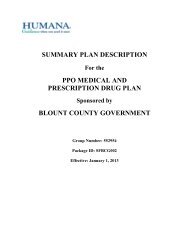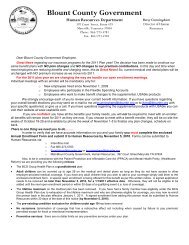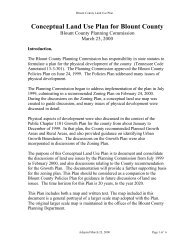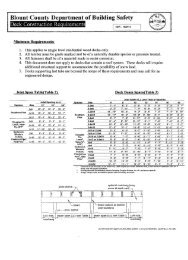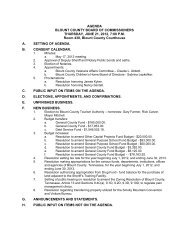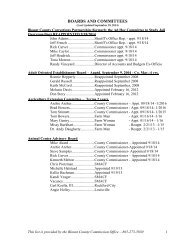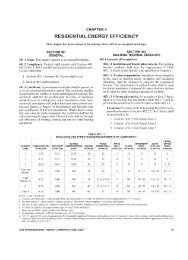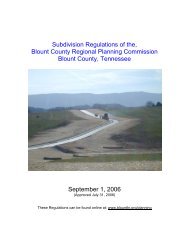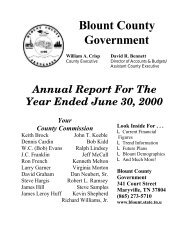Reflections on the 1101 Process in Blount County, Tennessee
Reflections on the 1101 Process in Blount County, Tennessee
Reflections on the 1101 Process in Blount County, Tennessee
Create successful ePaper yourself
Turn your PDF publications into a flip-book with our unique Google optimized e-Paper software.
Maryville appo<strong>in</strong>tment of <strong>the</strong> plann<strong>in</strong>g commissi<strong>on</strong> member may be seen as be<strong>in</strong>gassociated with both city and county governments. The rema<strong>in</strong>der were nom<strong>in</strong>ally<strong>in</strong>dependent. The county government was thus a dist<strong>in</strong>ct m<strong>in</strong>ority <strong>in</strong> representati<strong>on</strong> <strong>on</strong><strong>the</strong> Coord<strong>in</strong>at<strong>in</strong>g Committee.Populati<strong>on</strong> Projecti<strong>on</strong>s: One of <strong>the</strong> basic plann<strong>in</strong>g <strong>in</strong>puts required by Public Chapter<strong>1101</strong> was populati<strong>on</strong> projecti<strong>on</strong>s. Projecti<strong>on</strong>s were provided by <strong>the</strong> University of<strong>Tennessee</strong> (UT). The local governments were given <strong>the</strong> opportunity to c<strong>on</strong>test <strong>the</strong>projecti<strong>on</strong>s, and to provide alternative figures for <strong>the</strong> <strong>1101</strong> process.The UT projecti<strong>on</strong>s (all rounded to nearest 100) showed <strong>Blount</strong> <strong>County</strong> grow<strong>in</strong>g to124,000 by <strong>the</strong> year 2020. The county c<strong>on</strong>tested <strong>the</strong> projecti<strong>on</strong>s, supply<strong>in</strong>g its ownprojected populati<strong>on</strong> of 136,000. The City of Alcoa was projected by UT to grow to8,800 by <strong>the</strong> year 2020. The City of Alcoa also c<strong>on</strong>tested <strong>the</strong> UT projecti<strong>on</strong>s, supply<strong>in</strong>gits own projected populati<strong>on</strong> of 15,000. The o<strong>the</strong>r towns and cities accepted <strong>the</strong> UTprojecti<strong>on</strong>s as follows: Maryville – 32,600; Louisville – 1,800; Friendsville – 1,300;Rockford 1,000; and Townsend – 600. Based <strong>on</strong> locally accepted projecti<strong>on</strong>s, <strong>the</strong> cityproporti<strong>on</strong> of populati<strong>on</strong> was expected to grow from about 35 percent <strong>in</strong> <strong>the</strong> year 2000 toabout 38 percent <strong>in</strong> <strong>the</strong> year 2020.Populati<strong>on</strong> Density: Populati<strong>on</strong> density was a major def<strong>in</strong><strong>in</strong>g characteristic of <strong>the</strong> threegrowth plan areas, with Urban Growth Boundaries be<strong>in</strong>g projected high densitydevelopment, Planned Growth Area be<strong>in</strong>g projected moderate to high density, and RuralArea be<strong>in</strong>g projected low to moderate density. Public Chapter <strong>1101</strong> did not provideguidance <strong>on</strong> how density would be applied at <strong>the</strong> local level. It was assumed that eachlocality would need to def<strong>in</strong>e density categories for local plann<strong>in</strong>g applicati<strong>on</strong>.There was no formal agreement <strong>on</strong> what high, moderate and low density developmentwas <strong>in</strong> <strong>Blount</strong> <strong>County</strong> for <strong>the</strong> purpose of def<strong>in</strong><strong>in</strong>g <strong>the</strong> three required areas. The generalc<strong>on</strong>sensus held that areas of high density development would be def<strong>in</strong>ed by reference to ahigh level of urban services, most particularly sewer. The <strong>County</strong> offered its ownanalysis of density categories based <strong>on</strong> criteria for approval of subdivisi<strong>on</strong>s <strong>in</strong> <strong>the</strong> countyplann<strong>in</strong>g commissi<strong>on</strong>.High density was def<strong>in</strong>ed <strong>in</strong> relati<strong>on</strong> to provisi<strong>on</strong> of sewer, which would allowsubdivisi<strong>on</strong> densities greater than 1.5 units per acre. Note that under <strong>County</strong> regulati<strong>on</strong>s<strong>the</strong> maximum density <strong>on</strong> sewer was about 4.6 units per acre, under Maryville regulati<strong>on</strong>s<strong>the</strong> maximum density was 6.2 units per acre, and under Alcoa regulati<strong>on</strong>s <strong>the</strong> maximumdensity exceeded 12 units per acre.Moderate density was def<strong>in</strong>ed as a range from <strong>on</strong>e unit per three acres to 1.5 units peracre. This was based <strong>on</strong> <strong>in</strong>formal observati<strong>on</strong> that most n<strong>on</strong>-mounta<strong>in</strong>ous development<strong>in</strong> <strong>the</strong> county <strong>on</strong> septic systems was with<strong>in</strong> that density range. The standard fordevelopment <strong>on</strong> <strong>in</strong>dividual septic systems was similar across all jurisdicti<strong>on</strong>s, be<strong>in</strong>g am<strong>in</strong>imum lot size of between 20,000 to 25,000 square feet if <strong>on</strong> public water.<strong>Blount</strong> <strong>County</strong> <strong>1101</strong> Growth Plann<strong>in</strong>g <strong>Process</strong> Page 3 of 14





